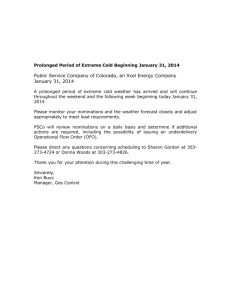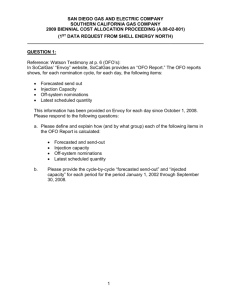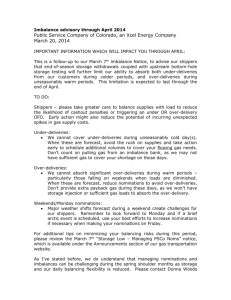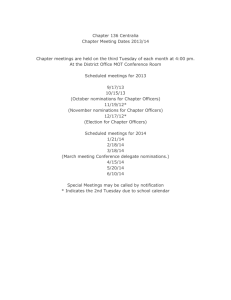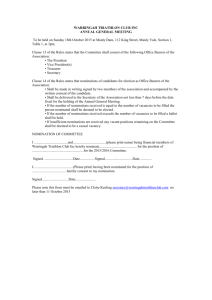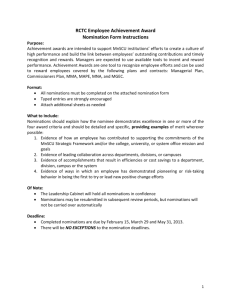IP-DR-02 - Southern California Gas Company
advertisement
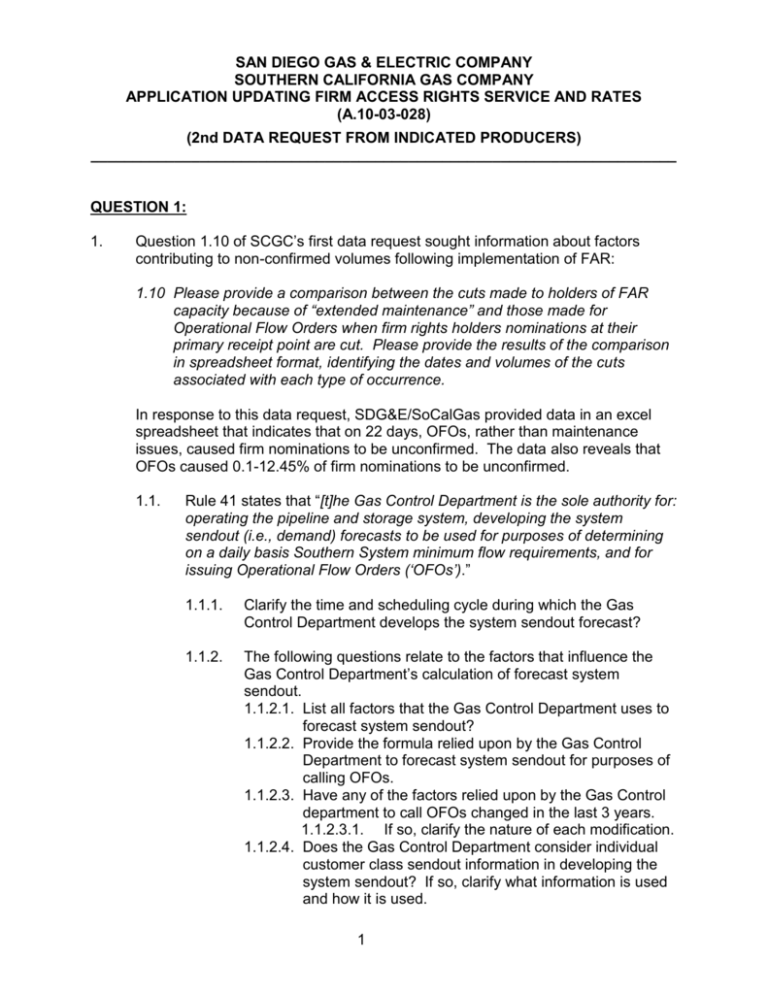
SAN DIEGO GAS & ELECTRIC COMPANY SOUTHERN CALIFORNIA GAS COMPANY APPLICATION UPDATING FIRM ACCESS RIGHTS SERVICE AND RATES (A.10-03-028) (2nd DATA REQUEST FROM INDICATED PRODUCERS) ______________________________________________________________________ QUESTION 1: 1. Question 1.10 of SCGC’s first data request sought information about factors contributing to non-confirmed volumes following implementation of FAR: 1.10 Please provide a comparison between the cuts made to holders of FAR capacity because of “extended maintenance” and those made for Operational Flow Orders when firm rights holders nominations at their primary receipt point are cut. Please provide the results of the comparison in spreadsheet format, identifying the dates and volumes of the cuts associated with each type of occurrence. In response to this data request, SDG&E/SoCalGas provided data in an excel spreadsheet that indicates that on 22 days, OFOs, rather than maintenance issues, caused firm nominations to be unconfirmed. The data also reveals that OFOs caused 0.1-12.45% of firm nominations to be unconfirmed. 1.1. Rule 41 states that “[t]he Gas Control Department is the sole authority for: operating the pipeline and storage system, developing the system sendout (i.e., demand) forecasts to be used for purposes of determining on a daily basis Southern System minimum flow requirements, and for issuing Operational Flow Orders (‘OFOs’).” 1.1.1. Clarify the time and scheduling cycle during which the Gas Control Department develops the system sendout forecast? 1.1.2. The following questions relate to the factors that influence the Gas Control Department’s calculation of forecast system sendout. 1.1.2.1. List all factors that the Gas Control Department uses to forecast system sendout? 1.1.2.2. Provide the formula relied upon by the Gas Control Department to forecast system sendout for purposes of calling OFOs. 1.1.2.3. Have any of the factors relied upon by the Gas Control department to call OFOs changed in the last 3 years. 1.1.2.3.1. If so, clarify the nature of each modification. 1.1.2.4. Does the Gas Control Department consider individual customer class sendout information in developing the system sendout? If so, clarify what information is used and how it is used. 1 SAN DIEGO GAS & ELECTRIC COMPANY SOUTHERN CALIFORNIA GAS COMPANY APPLICATION UPDATING FIRM ACCESS RIGHTS SERVICE AND RATES (A.10-03-028) (2nd DATA REQUEST FROM INDICATED PRODUCERS) ______________________________________________________________________ 1.1.3. Identify the department that calculates the core customer class forecast sendout. 1.1.3.1. Identify all factors that can impact the calculation of core forecasted sendout. 1.1.3.2. What factors in the calculation of the core customer class’ forecast sendout are left to this department’s discretion? 1.1.3.3. How frequently does this department forecast the core customer class’ sendout? 1.1.3.4. Once this department forecasts the core customer class’ sendout, does it update the forecast if factors identified in response to Question 1.1.3.1 change the calculation of core customer class forecast sendout? Please explain. 1.1.4. Please explain how the core customer class imbalance is calculated. List all factors that influence this calculation. 1.2. There are several dates reflected in the excel spreadsheet SDG&E/SoCalGas’ provided in response to Question 1.10 of SCGC’s first data request on which nominations were not confirmed despite there being no maintenance issues or OFOs called. The percentages of nonconfirmed volumes ranged from 0.1-14.22% on these days. List all factors that contributed to nonconfirmed nominations on these days. 1.3. From October 2008 through July 21, 2009, SoCalCas’ response indicates that there were no maintenance issues responsible for nonconfirmed nominations. Despite this, the data reveals that during this period, there were 22 days on which nonconfirmed volumes resulted from OFOs. What factors contributed to the OFOs that occurred on these days? 1.4. Data on Envoy reveals that from October 2008 through July 21, 2009, there were 14 OFOs that are not reflected in SoCalGas’ response to Question 1.8: October 20, 2008 October 26, 2008 October 27, 2008 October 31, 2008 November 3, 2008 November 10, 2008 November 11, 2008 November 12, 2008 2 SAN DIEGO GAS & ELECTRIC COMPANY SOUTHERN CALIFORNIA GAS COMPANY APPLICATION UPDATING FIRM ACCESS RIGHTS SERVICE AND RATES (A.10-03-028) (2nd DATA REQUEST FROM INDICATED PRODUCERS) ______________________________________________________________________ November 14, 2008 November 17, 2008 November 18, 2008 November 22, 2008 November 23, 2008 December 7, 2008 Were these OFOs a factor that contributed to the nonconfirmed nominations that resulted on these dates? Response 1 The overall characterization made by Indicated Producers of the response in SCGC 1.10 is incorrect. Nowhere in that data response did SoCalGas claim that OFOs had caused the nomination cuts; the data response merely quantified the cuts occurring on OFO days. In fact, the data shows that cuts on OFO days during that period were not significantly above cuts on the other days in that period. During the 22 OFOs days from October 2008 through July 22, 2009, the average level of cut was 3%. During the entire 293 day period the average cut was 1%, which is not significantly different than the average 3% cut on the 22 OFO days. Even if one were to assume that cuts on OFO were entirely caused by the OFO, the 3% cuts on the OFO days (8% of the total) would only explain 0.25% (3%x8%) of the average 1% daily cut over this 293 day period. Factors other than major pipeline maintenance or OFOs explain most of the relatively minor cuts over this period. See IP’s own list in question 3 for these factors. RESPONSE 1.1.1: Sendout and other OFO calculations are made between 5:30 and 6:00 AM for Cycles 1&3. These calculations are made between 12:30 and 1:00 PM for Cycles 2 & 4. RESPONSE 1.1.2.1: The Gas Control department uses temperature and weather forecasts, historical data, both public and private market data, and operating experience with the SoCalGas/SDG&E gas transmission system to determine the system demand forecast. 3 SAN DIEGO GAS & ELECTRIC COMPANY SOUTHERN CALIFORNIA GAS COMPANY APPLICATION UPDATING FIRM ACCESS RIGHTS SERVICE AND RATES (A.10-03-028) (2nd DATA REQUEST FROM INDICATED PRODUCERS) ______________________________________________________________________ RESPONSE 1.1.2.2 There is no specific formula used by the Gas Control department. Please refer to Response 1.1.2.1 of this data request for the factors considered by the Gas Control department when developing the daily forecast of demand. RESPONSE 1.1.2.3: No. RESPONSE 1.1.2.4: Yes. Please refer to Response 1.1.2.1 of this data request. RESPONSE 1.1.3: The Core Forecast is part of the Daily Load Forecast which is calculated by the Gas Rates and Analysis Group in the Regulatory Affairs Department of SCG. This forecast is not used by Gas Control for purposes of estimating system sendout. RESPONSE 1.1.3.1: The Daily Load Forecasting Model (DLFM) has two components: weather sensitive and non-weather sensitive parts. The weather sensitive part depends on the daily forecasted temperature while the non-weather sensitive part depends on the calendar month of the year, the day of the week (weekend versus non-weekend day, and if an observed holiday occurs on a weekday) together with monthly gas rates for core customers. These parts also include expected customer growth. The weather forecast is received from DTN/ Meterorlogix, an independent weather forecasting company. The monthly retail core customer growth is developed from the SCG and SDG&E customer billing files each month. The current DLFM is based on two years of historical SCG and SDG&E retail core gas usage data. The dependent variable of daily core load is derived from daily operational Measurement Collection System (MCS) data. Historical weather data in the SCG and SDG&E service territories are used to identify the weather sensitive parts of each model. RESPONSE 1.1.3.2: The Daily Load Forecast is reviewed over a 10-day period to see how it tracks with the daily MCS operational data issued by the meter reading and billing department that tracks system sendout, as provided by the system operator, with raw noncore electronic metering data to derive daily core load. The equation is as follows: system sendout – raw noncore electronic metering data = core usage. As stated above, this is operational data not of billing quality. If the Daily Load Forecast over a 10-day period appears to be 4 SAN DIEGO GAS & ELECTRIC COMPANY SOUTHERN CALIFORNIA GAS COMPANY APPLICATION UPDATING FIRM ACCESS RIGHTS SERVICE AND RATES (A.10-03-028) (2nd DATA REQUEST FROM INDICATED PRODUCERS) ______________________________________________________________________ over or under forecasting core load, an adjustment is made to bring the Daily Load Forecast in line with MCS. This review and adjustment is ongoing on a daily basis. RESPONSE 1.1.3.3: The Daily Load Forecast is sent out once each day as follows: At 4:05 AM, weather data (hourly, temperatures) are retrieved from DTN/Meteorlogix; At 4:15 AM, automated calculations are done for core load forecasts; and At 4:35 AM, a file of data is sent to the ENVOY system and to the PINNACLE system in the Gas Acquisition Department. RESPONSE 1.1.3.4: No, once the core forecast is posted for the day at 4:35 AM it is not changed. RESPONSE 1.1.4: Please refer to SoCalGas’ Rate Schedule G-IMB, SoCalGas’ Rules No. I and No. 30. RESPONSE 1.2: See IP’s list in question 3 for a description of the various factors that can lead to cuts. RESPONSE 1.3: See IP’s list in question 3 for a description of the various factors that can lead to cuts. RESPONSE 1.4: Of the dates listed, only December 7, 2008 was an OFO day. The percentage cut on December 7, 2008, according to SCGC response 1.10, was 0.1 percent. Obviously OFOs were not a significant factor for the cuts on other the dates listed. In addition December 7, 2008 was not included in the response to SCGC DR 1.8 because that data request dealt with period August-December 2009. 5 SAN DIEGO GAS & ELECTRIC COMPANY SOUTHERN CALIFORNIA GAS COMPANY APPLICATION UPDATING FIRM ACCESS RIGHTS SERVICE AND RATES (A.10-03-028) (2nd DATA REQUEST FROM INDICATED PRODUCERS) ______________________________________________________________________ QUESTION 2: 2. On page 3, lines 6-7, Rodger Schwecke states “Following FAR, and excluding the Line 235-2 maintenance period, only 1% of all firm nominations were not confirmed by SoCalGas.” In the excel spreadsheet SDG&E/SoCalGas provided in response to Question 1.10 of SCGC’s first data request, the percentage of nonconfirmed volumes from October 1, 2008 through July 21, 2009 ranged from .01%-14.22%. Based on this information, how did Mr. Schwecke conclude that 99% of all firm nominations were confirmed during the period preceeding Line 235-2 maintenance? RESPONSE 2: The daily average “percent non-confirmed” for the 293 days from October 1, 2008 through July 21, 2009 in SCGC Response 1.10 is 1.05%. Therefore, 99% of all firm nominations were confirmed during the period pre-ceeding Line 235-2 maintenance. 6 SAN DIEGO GAS & ELECTRIC COMPANY SOUTHERN CALIFORNIA GAS COMPANY APPLICATION UPDATING FIRM ACCESS RIGHTS SERVICE AND RATES (A.10-03-028) (2nd DATA REQUEST FROM INDICATED PRODUCERS) ______________________________________________________________________ QUESTION 3: 3. In response to Question 1.9.2 of SCGC’s first data request, SDG&E/SoCalGas provided data clarifying the reasons for unconfirmed nominations from March 19, 2010 through the March 31, 2010. The data clarifies that during this timeframe firm nominations were not confirmed for the following reasons: Reduction Codes CBL-P CBL-R CPR CRN ECM-F PCC-C PCC-R PCC-S PRR REIN 3.1. 3.2. Contract Balancing at Pool-Reduction due to City Gate Pool Balancing Contract Balancing at RPAC-Reduction due to RPAC balancing Confirming Party Reduction-If supply confirmation quantity is less than the nomination quantity, Envoy will reduce the nomination quantity to equal the supply confirmation Confirmation response not received-If there is no supply confirmation quantity, Envoy will reduce the nomination quantity to zero Exceeded Contract MDQ-The total quantity for the firm RPAC exceeds the RPAC rights. Pipeline Capacity Constraint-System Capacity-Reduction of nominations of the system capacity. This occurs on OFO days on Intraday 1 and Intraday 2 Cycles Pipeline Capacity Constraint-Receipt Point-Reduction of nominations to the receipt point capacity Pipeline Capacity Constraint-Sub Zone-Reduction of nominations to the sub zone capacity. Pipeline Reduction at Receipt-The Upstream Operator scheduled less than what was confirmed Reinstatement Please explain each term and clarify the factors that contribute to each of these conditions. Please provide numeric examples that demonstrate how each of the conditions listed in the table above can be a factor that precludes firm nominations from being confirmed. RESPONSE 3.1: SoCalGas does not fully understand the question and to which terms IP is referring. The table itself provided in IP’s question provides definition of terms. A reduction code description has been provided for each reduction code term. Many of these same reduction codes and descriptions are commonly used by other pipelines. 7 SAN DIEGO GAS & ELECTRIC COMPANY SOUTHERN CALIFORNIA GAS COMPANY APPLICATION UPDATING FIRM ACCESS RIGHTS SERVICE AND RATES (A.10-03-028) (2nd DATA REQUEST FROM INDICATED PRODUCERS) ______________________________________________________________________ RESPONSE 3.2: At the close of each nomination cycle, SoCalGas performs a balancing function of all nominations received for that cycle. This process ensures that the receipt and delivery nominations are valid; do not exceed contractual rights; that for each delivery nomination received there is a corresponding receipt nomination; and finally the total amount of gas nominated for delivery and injection does not exceed the total system capacity and storage injection capacity. If the receipt and delivery nominations do not match in quantity, the lesser of that quantity is confirmed (CPR). If a customer nominates more than their contractual rights for either their firm or interruptible RPAC, SoCalGas will only confirm the quantity up to their contact rights (ECM-F; ECM-I). In addition, if there is no reciprocal delivery or receipt nomination, the nomination will not be confirmed by SoCalGas (CRN). Finally, if a reduction was made to an RPAC or a Citygate Pool transaction upstream or downstream of a transaction that stands in the middle, then that transaction must be adjusted and a contract balancing reduction code is provided (CBL-P; CBL-R). During this balancing process other types of reductions can be made. For example if customer nominations exceed receipt point, sub-zone or zone capacities due to maintenance or over-nominating then nominations are reduced to the receipt point, subzone or zone capacities (PCC-R; PCC-S; PCC-Z). If after the above process is completed and the total nominations still exceed the total system capacity plus storage injection, reductions are made to the nominations across the system in accordance to the scheduling priorities in Rule 30, D. Operational Requirements, 3. Receipt Point Capacity (PCC-C). Once this final process takes place and it is determined that there is capacity left over, nominations that were reduced earlier in the process due to contract balancing may be reinstated (REIN). The results of the balancing process for the nominations received then become the confirmations that SoCalGas provides the upstream suppliers. Confirmed nominations at the RPAC are the only confirmed nominations provided to upstream suppliers. Several hours later after the upstream suppliers have gone through a similar balancing process they in turn provide SoCalGas with the scheduled quantities. If the scheduled quantities are less than what SoCalGas confirmed to the upstream suppliers, SoCalGas will provide a reduction code (PRR). 8
